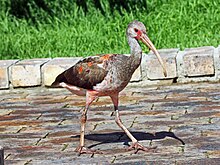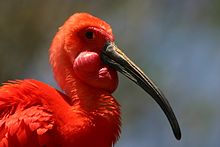
The ibis are a group of long-legged wading birds in the family Threskiornithidae that inhabit wetlands, forests and plains. "Ibis" derives from the Latin and Ancient Greek word for this group of birds. It also occurs in the scientific name of the western cattle egret mistakenly identified in 1757 as being the sacred ibis.
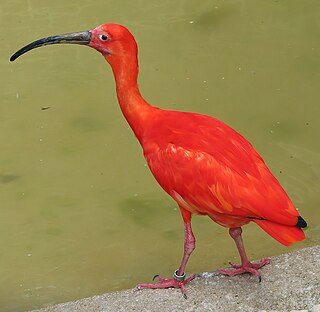
The family Threskiornithidae includes 36 species of large wading birds. The family has been traditionally classified into two subfamilies, the ibises and the spoonbills; however recent genetic studies have cast doubt on this arrangement, and have found the spoonbills to be nested within the Old World ibises, and the New World ibises as an early offshoot.

The American white ibis is a species of bird in the ibis family, Threskiornithidae. It is found from Virginia via the Gulf Coast of the United States south through most of the coastal New World tropics. This particular ibis is a medium-sized bird with an overall white plumage, bright red-orange down-curved bill and long legs, and black wing tips that are usually only visible in flight. Males are larger and have longer bills than females. The breeding range runs along the Gulf and Atlantic Coast, and the coasts of Mexico and Central America. Outside the breeding period, the range extends further inland in North America and also includes the Caribbean. It is also found along the northwestern South American coastline in Colombia and Venezuela. Populations in central Venezuela overlap and interbreed with the scarlet ibis. The two have been classified by some authorities as a single species.

The Australian white ibis is a wading bird of the ibis family, Threskiornithidae. It is widespread across much of Australia. It has a predominantly white plumage with a bare, black head, long downcurved bill, and black legs. While it is closely related to the African sacred ibis, the Australian white ibis is a native Australian bird. Contrary to urban myth, it is not a feral species introduced to Australia by people, and it does not come from Egypt.

The rufous-vented chachalaca is a member of an ancient group of birds of the family Cracidae, which are related to the Australasian mound builders. It inhabits northeast Colombia and northern Venezuela where it is called guacharaca, and the island of Tobago in Trinidad and Tobago where it is known as the cocrico and is one of the country's two national birds. It is also found on Bequia and Union Island in the Grenadines where it may have been introduced.

The bearded bellbird, also known as the campanero or anvil-bird, is a passerine bird which occurs in northern South America. The male is about 28 cm (11 in) long with white plumage apart from a brown head and black wings. At his throat hang several black, unfeathered wattles. The female is a little smaller with olive-green head and upper parts, yellow underparts streaked with green and a yellow vent area. The male has a loud, repeated metallic hammering call, as well as various other vocalisations.
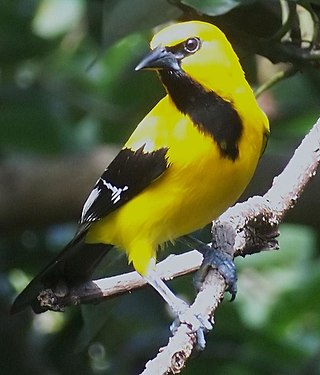
The yellow oriole is a passerine bird in the family Icteridae. It should not be confused with the green oriole, sometimes alternatively called the Australasian yellow oriole, which is an Old World oriole.

The collared trogon is a near passerine bird in family Trogonidae, the quetzals and trogons. It is found in Mexico, throughout Central America, and in northern South America.

The Caroni Swamp is the largest mangrove wetland in Trinidad and Tobago. It is located on the west coast of Trinidad, south of Port of Spain and northwest of Chaguanas, where the Caroni River meets the Gulf of Paria.

The spectacled thrush, bare-eyed thrush, or yellow-eyed thrush, is a resident breeding bird in the Lesser Antilles and in South America from Colombia and Venezuela south and east to northern Brazil. In Trinidad and Tobago, this thrush is also known as big-eye grieve.

The red siskin is a small endangered finch.

The ruddy ground dove is a small New World tropical dove. It is a resident breeder from Mexico south to Brazil, Peru and Paraguay, and northern Argentina, and on Trinidad and Tobago. Individual birds can sometimes be seen in the southwestern USA, from southern Texas to southernmost California, primarily during winter.

The eared dove is a New World dove. It is a resident breeder throughout South America from Colombia to southern Argentina and Chile, and on the offshore islands from the Grenadines southwards. It may be a relatively recent colonist of Tobago and Trinidad. It appears to be partially migratory, its movements driven by food supplies.

The pale-vented pigeon is a large pigeon found in the tropical Americas. Formerly often placed in Columba, it actually belongs to a clade of the older New World genus Patagioenas. With its relatives it represents an evolutionary radiation extending through most of the warm-temperate to tropical Americas. Grey-hued birds, even their males generally lack iridescent display plumage, although the present species has some coppery gloss on the nape.

The collared plover is a small shorebird in the plover family, Charadriidae. It lives along coasts and riverbanks of the tropical to temperate Americas, from central Mexico south to Chile and Argentina.
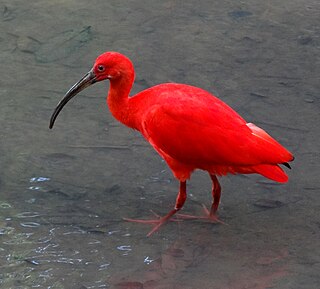
Eudocimus is a genus of ibises, wading birds of the family Threskiornithidae. They occur in the warmer parts of the New World with representatives from the southern United States south through Central America, the West Indies, and South America.

The white-collared swift is a species of bird in the subfamily Cypseloidinae of the swift family Apodidae. It is found in Mexico, the Greater and Lesser Antilles, Trinidad, and every mainland South American country except Chile.

The maguari stork is a large species of stork that inhabits seasonal wetlands over much of South America, and is very similar in appearance to the white stork; albeit slightly larger. It is the only species of its genus to occur in the New World and is one of the only three New World stork species, together with the wood stork and the jabiru.
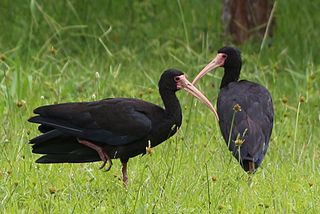
The sharp-tailed ibis is a species of ibis native to open wet savannas in parts of northern South America.



